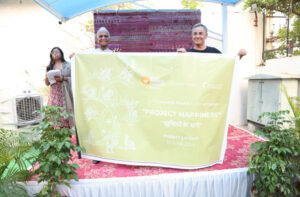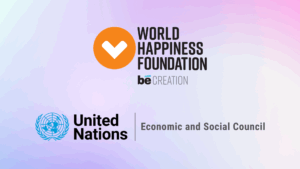
A Dream Come True: My Journey with NKC and the Team at Jaipur Rugs
As I reflect on the incredible journey I’ve had the

The research on animals really helped me understand myself, my automatic responses and to redirect those responses. And that’s the whole goal of my work: first, to be honest about our inner mammal, and then second, to understand our power to redirect it individually in our own heads.
We tend to idealize the social bonds of animals, and it’s easy to project onto them that they’re all warm and fuzzy and nice to each other. But the reality we know is that animals have a lot of conflict in their groups, so animals stick with their groups despite the conflict because it gives them protection from predators.
So we all like our independence, but when we feel threatened, we look for the safety of social support. So we want both. We want that independence, but we want that safety of social support and both are natural. So self-acceptance is a big part of making peace with your inner mammal.
We know an isolated mammal is quickly killed by predators, so natural selection builds a brain that rewards you with the good feeling of oxytocin when you find social support. When you have social support, you can lower my guard because if there’s danger, the rest of the herd will alert you. And that’s what allows a herd animal to relax enough to eat rather than constantly being on high alert for predators.
Our brain is not designed to release oxytocin all the time. This is the frustrating part. The truth is, everybody’s oxytocin is low until they do something to stimulate it, and then in a short time it’s metabolized and then it’s gone, and then you have to do something to stimulate it again. That is how our brain is designed to work. If you had oxytocin all the time, you would lower your guard when you should not.
So trust is what the mammal brain is really looking for. We define trust with oxytocin pathways built from past experience, which is indeed complex. Each brain expects conflict or rejection where they found it before. Now the conflict or rejection, and we all have both of your youth is what built the biggest pathways in your brain. If you build trust with individuals, you’re less dependent on the herd for your oxytocin.
Now let’s talk about small steps, repeated small acts of trust stimulate oxytocin and realistic expectations. This is the complication of life: We have big expectations about social support. We define social support in some grand way because when we’re young, we need so much support. And when we’re young is when our brain is wired. So we wire in the expectation that the world should support me. And that’s just not realistic. But nobody is out there telling you that. So I’m telling you that.
Read Loretta Breuning’s full article here.
I’m the CEO and founder of the Flourishing Center. And since 2008, we have been training practitioners from all over the world in how to put the science of positive psychology and mind body medicine into practice.
When we talk about being happy, we are talking about a number of different things. But in Positive Psychology we define happiness as a sense of satisfaction with one’s life. I personally like to think of it as having personal mastery, the ability to feel the way you want to feel when you want to feel it.
And what better way to learn how to master oneself than to master being able to shift how you feel in real time? Before we start applying an intervention, we want to get to what we call a SUD.
SUD stands for a subjective unit of distress. So before I use these skills with people, I usually just have them check in and ask them on a scale of zero to ten, how strong is what you’re feeling? Because if we’re going to talk about shifting feelings, we want to first understand where we starting off with. That was within one of the simple ways that we can begin to cultivate what we call Emotional Intelligence, giving people the opportunity to pause and check in and ask themselves, how am I feeling right now in this moment?
This also becomes really important because we need different tools at different levels on the scale. So I’m going to present these skills to you and actually give them to you in order from skills that I would use when somebody is all the way up in very, very, very intense emotions and then kind of rank order them to simpler techniques that can be used a little bit further down.
There’s no, no right way to feel. But what is important is to feel because feeling we as human beings. We feel first, we think of ourselves as thinkers, but really, we’re feeling creatures. Emotions are the spice of life. They are the things that color our lives.
Get the 10 techiniques here.
When I was thinking about writing a book on emotional intelligence, I thought, do I call it emotional intelligence? And I was like, I don’t think so. There’s something deeper that I think we have to get to before we learn about Emotional Intelligence. And I think it’s what I call permission to feel. And so my first hope is that we create a world where people have the permission to feel all emotions, where they feel safe and valued and incapable of doing that. And then I think we need to become curious explorers of our feelings.
I call that being an Emotion Scientist vs. an Emotion Judge. So first thing, we have to get critical: am I feeling angry or am I just irritated? Am I jealous? Am I envious? Am I stressed or am I overwhelmed? And then we have to become skilled. Emotional intelligence is about using our emotions wisely.
I call those skills the ruler skills. And there are five:
And that’s the ruler. I think most people are looking for strategies to be happy. And while I think happiness is important, I think it can’t be the only goal, because what happens is that if we strive all the time just to be happy, then we’re missing out on the informational value of frustration, anxiety, and stress. So to me, it’s more about a balance of emotion. And I do feel strongly that we want to experience more pleasant emotions than unpleasant ones in life, but we don’t want to get rid of the negative ones.
We’re more complex than we give ourselves credit for. Our bodies and brains can handle more than one feeling at a time. So now, I grant you now the permission to feel all emotions!
Read Marc Brackett’s full article here.
If you really look at the heart of it, technology is a very broad topic area. It basically means based on some theory or science to create something skillfully. It’s sort of a craft or an art form of manifesting our ideas and sort of applying our ideas in the real world to create something.
Technology manifests its creators’ values into the world. So whatever those values might be, we can manifest them into technology, and the technology can reflect, amplify, and expand those values and it will lead to both intended and unintended consequences. Sometimes it can kind of spin out of control all the way to the point that we actually have a mechanistic understanding that’s emerging of how this actually affects the brain.
Not only do we start to see changes in the brain when you meditate, we can also see long lasting traits, long term changes in the brain of people who actually spend a lot of time meditating, people who have meditated for years or even decades. And perhaps most interesting, we’re also correlating those changes to positive impacts on symptomology related to anxiety and depression.
We’re seeing physiological impacts. We’re seeing changes to relationships in pain and the immune system and even skin conditions and heart disease. And we’re even starting to see the positive psychology in terms of how mindfulness increases your sense of wellbeing and your psychological and mental health. I want to shift your perspective about technology. I want you to understand that. Sure, you can say something like I’m addicted to technology or technology is ruining society or whatever it might be. And there are areas where that’s true.
But there are also areas where technology is extremely beautiful and actually transforming society in a wonderful way. And we need to get a little bit more nuanced. The second reason I want to talk about this is I’m Super passionate about what these technologies can do in our lives. And I want all of you to try some of them. Some of these are things you can look up. You can watch YouTube videos about. You can actually download to your phone and play with. And then the third reason is I know some of the people behind the technologies I’m going to talk to you about, and their work is amazing.
And I think it deserves more attention, and I really want to profile some of it. So there’s a lot of really cool technologies out there. I really wanted to encourage you to try them out and to shift your perspective on what technology can be in terms of happiness. So I hope this was helpful.
See all the technological tools for mindfulness here.


As I reflect on the incredible journey I’ve had the

By Luis Miguel Gallardo, President of the World Happiness Foundation

As I sit on the banks of the Ganga in
